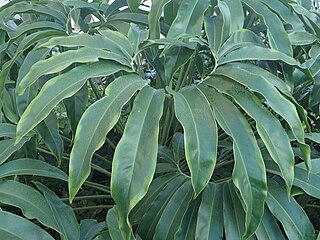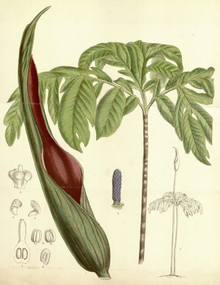
Guava is a common tropical fruit cultivated in many tropical and subtropical regions. The common guava Psidium guajava is a small tree in the myrtle family (Myrtaceae), native to Mexico, Central America, the Caribbean and northern South America. The name guava is also given to some other species in the genus Psidium such as strawberry guava and to the pineapple guava, Feijoa sellowiana. In 2019, 55 million tonnes of guavas were produced worldwide, led by India with 45% of the total. Botanically, guavas are berries.

Phytophthora is a genus of plant-damaging oomycetes, whose member species are capable of causing enormous economic losses on crops worldwide, as well as environmental damage in natural ecosystems. The cell wall of Phytophthora is made up of cellulose. The genus was first described by Heinrich Anton de Bary in 1875. Approximately 210 species have been described, although 100–500 undiscovered Phytophthora species are estimated to exist.

Hibiscus tiliaceus, commonly known as the sea hibiscus or coast cottonwood, is a species of flowering tree in the mallow family, Malvaceae, with a pantropical distribution along coastlines. It has also been introduced to Florida and New Zealand. It has been debated whether this species is native or introduced to Hawaii.

Nepenthes mirabilis, or the common swamp pitcher-plant and tropical pitcher plant, is a carnivorous plant species. By far the most widespread of all Nepenthes, its range covers continental Southeast Asia and all major islands of the Malay Archipelago, stretching from China in the north to Australia in the south. The species exhibits great variability throughout its range. One of the more notable varieties, N. mirabilis var. echinostoma, is endemic to Borneo and possesses an extremely wide peristome.

Nepenthes maxima, the great pitcher-plant, is a carnivorous pitcher plant species of the genus Nepenthes. It has a relatively wide distribution covering New Guinea, Sulawesi, and the Maluku Islands. It may also be present on Wowoni Island.

Dracontium is a genus of flowering plants similar to those of Amorphophallus. Unlike Amorphophallus which is found in the Old World, this genus has a New World distribution and is native to South America, Central America, southern Mexico, and the West Indies.

Bothrops jararaca—known as the jararaca or yarara—is a highly venomous pit viper species endemic to South America in southern Brazil, Paraguay, and northern Argentina. The specific name, jararaca, is derived from Old Tupi îararaka. Within its geographic range, it is often abundant and is an important cause of snakebite. No subspecies are currently recognized.

The wildlife of Cambodia is very diverse with at least 162 mammal species, 600 bird species, 176 reptile species, 900 freshwater fish species, 670 invertebrate species, and more than 3000 plant species. A single protected area, Keo Seima Wildlife Sanctuary, is known to support more than 950 total species, including 75 species that are listed as globally threatened on the IUCN Red List. An unknown amount of species remains to be described by science, especially the insect group of butterflies and moths, collectively known as lepidopterans.

Thyrsodium is a genus of plants in the family Anacardiaceae. It includes six species native to tropical South America, from Colombia to Bolivia and southeastern Brazil.

Utricularia arenaria is a small annual carnivorous plant that belongs to the genus Utricularia. It is native to tropical and southern Africa, where it can be found in Angola, Burundi, Cameroon, Côte d'Ivoire, the Democratic Republic of the Congo, Ethiopia, Gabon, Ghana, Kenya, Madagascar, Malawi, Mali, Mozambique, Nigeria, Senegal, Sierra Leone, South Africa, Sudan, Tanzania, Togo, Uganda, Zambia, and Zimbabwe. There has also been a single collection from central India in Madhya Pradesh. U. arenaria grows as a terrestrial plant in damp, sandy or peaty soils in swampy grasslands or marshes at altitudes from near sea level to 2,400 m (7,874 ft). It was originally described and published by Alphonse Pyrame de Candolle in 1844.

Peru has some of the greatest biodiversity in the world. It belongs to the select group of mega diverse countries because of the presence of the Andes, Amazon rainforest, and the Pacific Ocean. It has the fourth-most tropical forests of any country and the ninth-most forest area. The country is ranked among the five countries with the greatest biodiversity in the world according to various studies.
Epidendrum spruceanum is an epiphytic reed-stemmed Epidendrum orchid native to the Tropical rainforest of Peru, Bolivia, and Brazil.

Cassia javanica, also known as Java cassia, pink shower, apple blossom tree and rainbow shower tree, is a species of tree in the family Fabaceae. Its origin is in Southeast Asia, but it has been extensively grown in tropical areas worldwide as a garden tree owing to its beautiful crimson and pink flower bunches.

Aspidosperma spruceanum is a species of flowering plant in the genus Aspidosperma. It is native to Brazil, Bolivia, Peru, and the Guianas.

Calycophyllum spruceanum, common names capirona and Pau-Mulato, is a canopy tree belonging to the Gardenia Family (Rubiaceae) indigenous to the Amazon rainforest. Its most interesting characteristic is its very shiny, highly polished green bark. The oblong leaves are up to seven inches in length. The white flowers are in small terminal clusters.

Compsocerus violaceus is a species of beetle in the family Cerambycidae. It occurs in South America, being common in southern Brazil, northern Argentina and Uruguay.

Thaumatophyllum is a genus of flowering plants in the arum family, Araceae. Its species are native to northern (tropical) South America.

The Serra Negra State Park Portuguese: Parque Estadual da Serra Negra is a state park in the state of Minas Gerais, Brazil. It protects a mountainous area in the Atlantic Forest biome, an important source of water in a dry region, and a potential source of tourism revenue in an area with many social problems.

Thaumatophyllum spruceanum is a neotropical hemiepiphytic or scrambling plant in the genus Thaumatophyllum, in the family Araceae. It is native to northern South America.

Dracontium gigas is an herbaceous rainforest plant of the calla family (Araceae), native to Central America. It resembles the Old World species Amorphophallus titanum but has a spadix that is shorter than the spathe, with a somewhat smaller inflorescence up to 34 in (86 cm) in height. The leaf is up to 11.5 ft (3.5 m) high by up to 8 ft (2.4 m) wide. The petiole of A. titanum can be 12 or more inches thick, but that of D. gigas is only 2 to 3 inches in thickness.



















